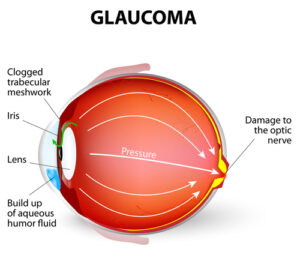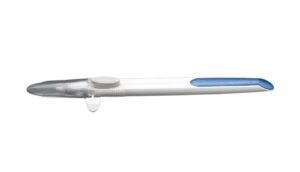Do you have glaucoma? Patients with glaucoma often say fatigue with taking eye drops prevents them from taking them properly. For those with open-angle glaucoma or high ocular tension, a new treatment called Durysta may be worth considering! Keep reading to learn more about Durysta and how it works!
The Basics of Glaucoma
One of the more common eye conditions a person can get as they get older is glaucoma. Glaucoma is a serious condition and one of the leading causes of blindness in adults over 60.

While there is no cure for glaucoma, there are many treatments available for it. Glaucoma is the name for a collection of diseases that damage the optic nerve.
The optic nerve is the part of your eye that sends messages from the eye to the brain so you can see the light that passes through the eye as images. When the optic nerve becomes damaged, it can’t send the full message to your brain, so the images you see appear incomplete.
People with glaucoma tend to lose their peripheral vision first which leads to a tunnel vision effect. In late-stage glaucoma, you may only be able to see within a very small visual field. Eventually, your vision can go completely black.
Unfortunately, you can’t repair damage to the optic nerve if it occurred. This means that any vision loss that glaucoma causes will be irreversible.
What Is Glaucoma and Does It Have Symptoms?
Another troubling fact about glaucoma is that it doesn’t present any symptoms. That means that most people don’t realize they have the condition until vision loss has already occurred.
This is why it’s so important to have regular eye exams. The importance of regular eye exams only increases as you get older.
At these eye exams, your eye doctor can measure your IOP or intraocular pressure. If these levels are out of balance, this is one of the first and only warning signs you may get.
Glaucoma is usually due to a buildup of fluids in the eye. It’s this buildup of fluids that puts pressure on the optic nerve. High IOP is usually the first sign of glaucoma.
The most common form of glaucoma is open-angle glaucoma. The angle in question is the anterior chamber angle.
The anterior chamber angle is a sort of drainage channel where the iris meets the cornea. In open-angle glaucoma, there’s nothing blocking this channel.
Fluid buildup occurs because of blockages in the trabecular meshwork. The trabecular meshwork is the semi-permeable tissue surrounding the eye that fluid from your eye naturally drains through.
Although there are other rarer forms of glaucoma, open-angle glaucoma is by far the most common. It’s also the kind of glaucoma that Durysta can treat.
Durysta: A Sustained-Release Implant
Durysta is an implant that your eye doctor inserts into your eye. It disperses a medication called bimatoprost into the eye that lowers IOP.

After implantation, Durysta will slowly release the medication over the course of several months. Many patients with glaucoma need to take eye drops that lower their eye pressure.
The problem with these drops is you must take them every day exactly as prescribed. This sustained-release implant is an effective, convenient alternative.
Durysta is best for patients with open-angle glaucoma or those with elevated IOP due to hypertension but they don’t have glaucoma yet. Unfortunately, Durysta cannot reverse damage to the optic nerve, but lowering IOP can prevent further damage due to glaucoma.
How Durysta Works
Durysta is an implant that slowly releases bimatoprost. The distribution of bimatoprost occurs under sustained release and targets the anterior chamber angle.
Bimatoprost is a substance that increases fluid flow through the eye. The medication increases the flow of fluid through both the trabecular meshwork and the anterior chamber angle. By increasing how much fluid can flow through both areas, it compensates for any blockage in the trabecular meshwork.
Patients will have the Durysta implant inserted into the anterior chamber of the eye with a special applicator. There’s no surgery needed.
Durysta is even dissolvable, meaning the implant will eventually dissolve in the eye. You don’t need to worry about having it removed its removal after Durysta is done working.
For most patients, the implant lasts about 4 or 5 months but this depends on the individual. Some patients have continued seeing lower IOP levels, even after Durysta has already dissolved in the eye.
Currently, you can only use Durysta for one treatment. You should not use it in the same eye more than once. After completing Durysta, you may need to find a different method for treating your glaucoma.
Who is a Good Durysta Candidate?

The only way to know for sure if you’re a candidate for Durysta is to schedule an appointment with your eye doctor. This glaucoma implant is only for patients with open-angle glaucoma or those with high eye pressure. Don’t take Durysta if you do not have open-angle glaucoma or high eye pressure.
Other reasons you may not be a candidate for Durysta include:
- Having narrow or obstructed iridocorneal angles
- You have an eye infection or an infection around your eye
- You have a condition called corneal endothelial cell dystrophy
- In the past, you’ve had a corneal transplant or an endothelial cell transplant
- You’re missing the posterior lens capsule or it’s torn
- You have an allergy to any of the ingredients in Durysta
- There’s a limited reserve of the corneal cells lining the inside of the cornea
- You may be more likely to develop swelling of the macula

If any of the above apply to you, Durysta may not be the best glaucoma treatment for you. Be sure to talk to your eye doctor about other options that may be a better fit instead.
If you’re a patient with open-angle glaucoma or high eye pressure that’s frustrated by taking daily eye drops, there’s a better way.
Ready to find out if Durysta could be the right fit for you? Schedule an appointment at Loden Vision Centers in Nashville, TN to learn more about this revolutionary glaucoma treatment!


